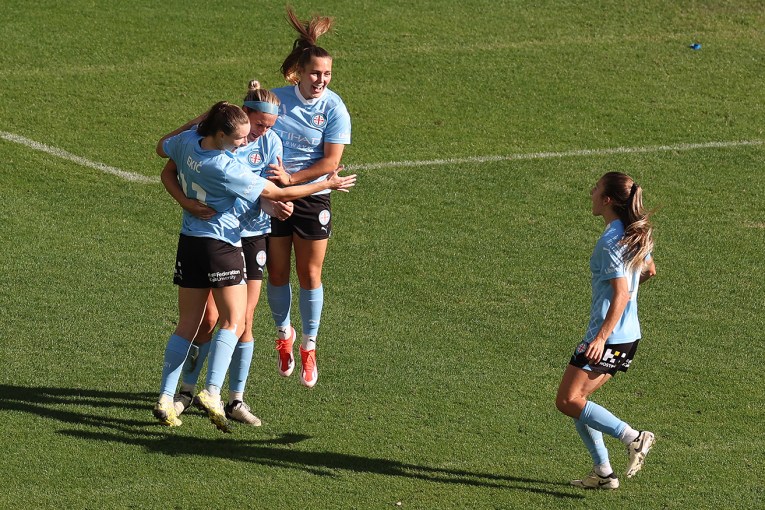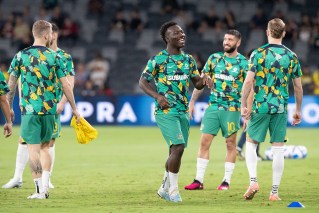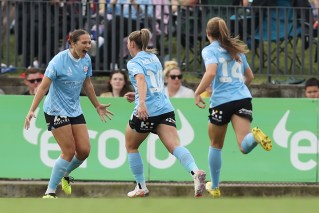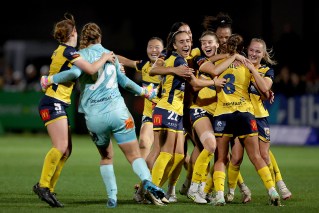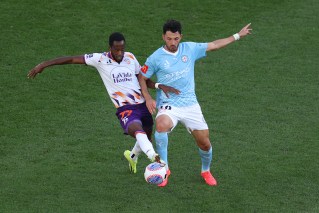Matildas’ stunning World Cup puts women’s sport pay debate in sharp focus
Optus Sport
Even the most avid supporters of women’s football in Australia could not have expected this.
The deafening roars of supporters in the stadiums. Thousands braving winter nights to gather and watch games on big screens at fan festivals.
Almost 25,000 spectators at a group stage match between Colombia and Korea at midday on a Tuesday.
These things are beyond the wildest dreams of what some might have thought possible for the FIFA Women’s World Cup – and yet it is all happening.
Even with the Matildas set to play England in a World Cup semi-final on Wednesday, after beating France in an incredible quarter-final on Saturday after a penalty shootout, this tournament has already been phenomenally successful.
Stadiums across the country are sold out, the resale platform is as in demand as Taylor Swift tickets, and still every day it seems like more people are coming on board to ride the wave of enthusiasm for women’s sport.
At the very head of all this of course are the Matildas. They are not Australia’s most successful women’s team – their record pales in comparison to the nation’s netball and cricket teams. Nor do they play Australia’s most-beloved sport – football has long languished behind Australian Rules, rugby league and cricket in the mainstream.
And yet it is this team that has sparked a cultural awakening – the scarves on the streets, the flags flapping on cars, the ‘Did you see the game last night?’ comments.
Those familiar hallmarks of men’s sport, this time, are signals that women’s sport has entered the mainstream.
The numbers
Matildas’ jerseys have been flying off the shelves – outselling the number of Socceroos jerseys sold for the men’s World Cup in 2022 before the first match was even played.
The television ratings for their round of 16 match against Denmark were almost inconceivable – bigger even than Australia’s two biggest men’s sporting events in the AFL grand final and rugby league’s State of Origin.
For Saturday evening’s stunning quarter-final penalty shootout win over France, the TV ratings went to another level.

Matildas fans cheer on in Melbourne during the match against France. Photo: Getty
More people watched this game than Ash Barty’s Australian Open win, Australia’s 2003 Rugby World Cup final, Lleyton Hewitt’s 2005 Australian Open final loss, and every AFL and NRL grand final of the past 20 years.
An average audience of 4.23 million people watched the Matildas beat France on the Seven Network, and that’s before accounting for people who watched on streaming app 7plus.
Only Cathy Freeman’s 400-metre win at the Sydney Olympics (8.8 million people) has eclipsed the win over France.
While Sam Kerr has long been a household name, so too are Steph Catley, Caitlin Foord, Mary Fowler and Ellie Carpenter part of the fabric of our sporting folklore.
So what is it about this team, this moment, that has cut through like no other before?
For no matter how successful women’s teams have been in the past, no matter how many surveys found Australia’s emotional attachment to the teams exceeded their male counterparts, never has there been this consistently high level of interest, day after day of back pages plastered with images of female athletes and stories leading the news bulletins.
The answer is varied and complex, but at its heart it can be boiled down to visibility.
Even the most ardent anti-sport devotee could not have shut out the noise that this tournament has created.
Even those most scathing of women’s sport, who linger in the Facebook comments of AFLW and Super Netball articles could not see that they are being left behind.
What media outlets, brands and sporting organisations are starting to notice is that women’s sport does not have to be treated like something they support to demonstrate their virtue.
Once just a few of these big players start treating it like the premium product it is, others catch on and suddenly the spotlights light up. One media outlet sees another generating clicks, a clothing brand watches its competitors’ products selling like hotcakes and the domino effect begins.
The all-encompassing nature of the World Cup has fast-tracked the process and Australia has been awakened.
Pay up
Most notably, this World Cup has shattered the old, tired arguments against pay parity.
The prize pool for the men’s World Cup in 2022 was $US440 million ($676 million), while the women will have access to just a quarter of that, with $US110 million ($169 million) allocated for this tournament.
That means that the Socceroos, who exited the men’s World Cup at the round of 16 stage, walked away with $US13 million ($20 million), more than three times what the winner of the women’s World Cup will receive.
With the Matildas making history as they surge towards the semi-finals for the very first time, the contrast in what they will receive in comparison to their male counterparts is stark.
That it has been not just results, but also ticket sales, merchandise and television ratings in which they have demonstrated their superiority puts a line through all those old disputes.
Now that people have seen the attention women’s sport can garner when it is given the same levels of investment and visibility as men’s, the ruse is up. It surely will not be long until sporting organisations are forced to act to bring these figures in line.
As the Matildas take one more step towards ultimate glory, the waves they are creating keep growing larger.
But in one way, they have already won.
After many years in the making, they have made the last push to make women’s sport an unstoppable force and at long last the Australian public has no interest in being an immovable object.
